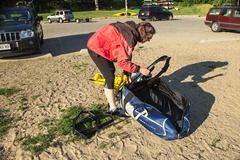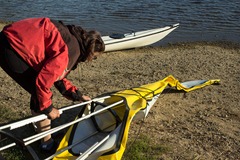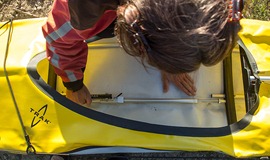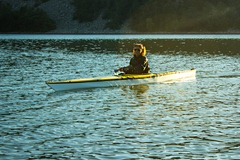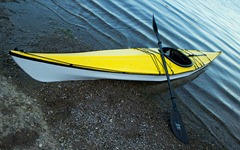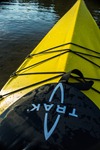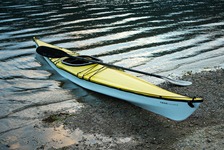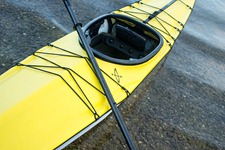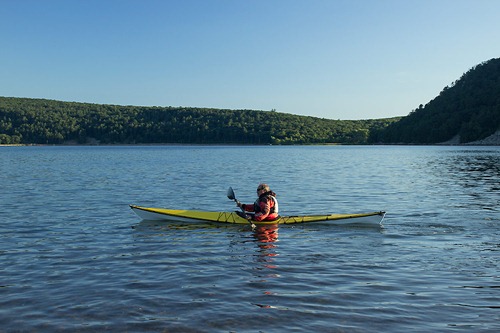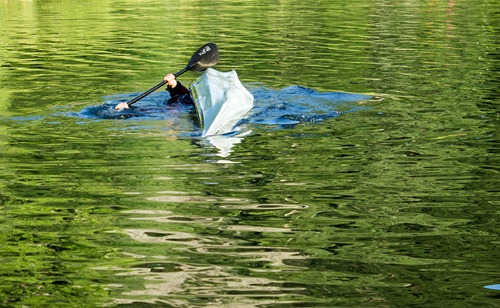[please login to make this ad block disappear]
Articles
Independent Playak Review: TRAK Seeker Kayak.
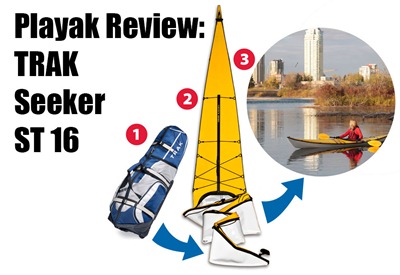 An independent Playak Review of the TRAK Seeker Kayak.
An independent Playak Review of the TRAK Seeker Kayak.
The TRAK Seeker ST 16 is a light, portable skin-on-frame kayak that uses modern design and materials to create a rigid framed performance kayak that you can take anywhere. The 16 foot, 48 pound boat comes packed inside its own travel bag and is advertised to set up in just 10 minutes. The combination of performance and portability of the Seeker make it worth a look for kayakers of all skill levels, especially those who love to travel or simply don’t have room to store a full sized sea kayak.
Introduction
In 2007 I was lucky enough to be one of the first paddlers in our part of the country to test the then brand new TRAK T-1600 folding kayak, (forerunner to the Seeker). For the better part of the next year I took one around the Midwest not only to test paddle, but to give other paddlers and coaches an opportunity to try out this new, innovative approach to folding kayaks. As with any new idea, there were some great ideas and some bits that needed work. With that in mind, I was really looking forward to testing the new Seeker ST 16 just to see how far TRAK kayaks had come.
Specs
• Kayak weight: 48 pounds
• Kayak length: 16 feet
• Weight 51.5 lbs
• Beam width: 22.5 inches
• Custom pocketed Trak spray skirt: Included
• Pack size: 52 by 17 by 15 inches (W x H x D)
• Cockpit size: 16.5 by 31.75 inches
• Assembly time: 10 minutes or less
• Storage capacity: Medium volume
• Water types: Flat water, ocean, and river (adaptable)
• Paddler level: Beginner to expert
• Warranty: 5 years
Quality
No question, everything about the TRAK Seeker is high quality. The frame is made of tough but flexible, aerospace-grade anodized aluminum. The PolyTrak shell is not only waterproof, but virtually, puncture proof and tear resistant as well according to TRAK. In my experience and in talking with folks who’ve paddled the TRAK over the last few years, everyone I spoke with was amazed by the toughness of the skin. Even the wheeled, OGIO® travel pack is well made and should last for years. The only long-term concern would be with the hydraulic pistons since they are a mechanical part, but to date I’ve heard of no problems.
Set-Up
TRAK proudly states that you can set up the Seeker in 10 minutes. Over the years I’ve had a lot of experience with the set up and yes, in time I could get it down to about 10 minutes if the wheels of the universe were spinning in my favor. Normally however, I found it took me about 15 minutes. For this review I decided to have someone who had never set up the TRAK to give it a go. We set the travel bag out on the beach and with a bit of ceremony, I paused, then shouted “Go” as I marked the time on my watch.
Now here’s the thing; No one, well almost no one, reads instructions (just ask IKEA!), so the design has to be intuitive right out of the box or you’ll have a frustrated customer straight away. It’s a major win for TRAK, that putting the Seeker together makes sense on sight. For the most part, it’s obvious what-goes-where. When it isn’t, the parts are attached with a bit of bungee that acts as a guide to the newbie boat builder. The only part of the assembly that will make you dig out the instructions is when inserting the hydraulics and attaching the combing. Learning to use that first hydraulic to stretch the frame before installing the others, then the combing is key. Otherwise the assembly of the TRAK Seeker goes like a clock work. Umm, speaking of clocks, it took this first timer about 25 minutes to set up the kayak. That includes blowing up the two float bags.
The Look
Hey, vanity is important! Once you have the kayak together on the beach, you’ll feel really good about the Seeker. It is an attractive kayak. The skin fits tightly on the frame, creating a sleek, smooth hull. We had a bright yellow over white version. The currently available colors are Deep Red, Yellow and Black (all over white). It certainly impressed the folks on the beach who were watching us put the Seeker together!
The Gear
To provide floatation, the Seeker comes with a set of 3-in-one float bags. They not only provide flotation, but act as dry bags allowing you to store your clothing, food and other supplies while on your trip. After you’ve put your gear inside, you roll them and clip them like any other dry bag. Once air tight, you can blow them up the rest of the way using the inflation tubes. While I was a bit worried that they may slowly leak over time, that wasn’t an issue during our tests. The downside of this system is that you’ll have to get out of your kayak to access your supplies. You will not want to use this kayak without the float bags in place.
The Seeker also comes with a one-size-fits-all skirt with a special pocket that allows you to adjust the kayak’s rocker without having to remove the skirt.
Paddlers can also buy a TRAK Aquatherm Sea Sock separately which I’d highly recommend when paddling the Seeker on big water.
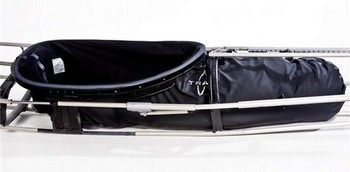
Performance
TRAK has worked hard to demonstrate that the Seeker can face the roughest waters the world has to offer. In skilled hands, this is true, but rough water is in my opinion, not the ideal world for the TRAK. The Seeker seems at its best in calm to mild weather conditions. We’ll talk more about that later on in the review.
When looking at the performance of the Seeker we need to first address the adjustable rocker. Rocker is a word we use to describe the curve of the kayak’s hull from front to back (bow to stern). The more rocker a kayak has, the more nimble it is. In general a kayak with more rocker will turn easily, but demands more skill from the paddler to stay on a straight line. A kayak with less rocker (less curve) will go straight, but demands more effort to turn. Most kayaks are designed with some level of compromise between the two.
The Seeker uses a hydraulic piston system that actually bends the frame inside the skin to add or lesson the curve of the hull, increasing and decreasing the kayak’s rocker on demand. A cool idea that for the most part works like a charm. When paddling the Seeker, adding more rocker is as simple as grabbing the hydraulic handle which sits between the paddlers legs, and pulling upwards. Each pump will add more rocker to the kayak’s hull. To release pressure and decrease the rocker, you turn a small valve on the hydraulic handle. Releasing pressure however, is not precise. Practically as soon as you release the valve, the pressure will let go and bring you back to “zero” tension (No rocker) in a heartbeat. To adjust the kayak’s rocker downward, you realistically have to release the tension, close the valve again, then pump the leaver back up to the desired position. Most paddlers will find a happy middle ground and make their adjustments on shore before heading out to paddle. That said, I can imagine situations where the ability to make adjustments on the water, would be a great advantage for the Seeker.
On the water, the Seeker is a stable kayak as suitable for beginners as it is for more advanced paddlers. My 12 year old son, who is about 5’4” and 130 lbs, took the Seeker out on an evening tour at our local lake and had no problems with stability or boat control. Frankly, I love the Seeker’s potential for beginning to intermediate paddlers looking for kayak that is easy to store, manage and transport. The Seeker would be the perfect solution for many paddlers looking to grow beyond recreational kayaking, while still wanting the perfect boat to “puddle” on inland lakes.
I find the Seeker edges and turns well once I found the “sweet spot” when it came to setting my rocker. Even with the hard chine, the secondary is solid and putting an edge on the boat is no problem.
The Seeker moves through the water well, although it doesn’t feel fast by sea kayak standards. My 5’7”, 210lb body does put a lot of boat in the water, and its 22.5 inch beam plays a role here as well. As always we tend to sacrifice a bit of speed when going for stability. I had no problem keeping up with others in their 17 foot, fiberglass boats, but I did feel like I was working harder to move the Seeker through the water than I would in my fiberglass kayaks.
The Seeker has no rudder or skeg and once again uses it’s unique hydraulic VariTrak/VariTrim system to actually “bend” the kayak left or right horizontally to deal with weathercocking (the tendency to turn upwind while moving forward in certain conditions). While I find this interesting, I never actually needed to make this adjustment with the Seeker or with my older T-1600. Weathercocking simply wasn’t enough of a problem.
In the end, the Seeker is an enjoyable kayak to paddle with no obvious flaws when it comes to boat control. In fact, the adjustability factor gives you the feeling of having a whole slew of kayaks to choose from on any given day.
Rolling
The first time I tried rolling a TRAK T-1600, the seat came loose, the combing popped and water was getting into the boat in buckets. Folks who tried the TRAK back then told me they had the same issues. Well, that was 6 years ago and I’m happy to say that those problems were addressed in the new Seeker. In my recent rolling sessions with the new Seeker, everything stayed in place. What’s more, the combing assembly did a pretty good job of keeping water out of the cockpit as well.
While the TRAK is a “skin-on-frame” kayak it’s not a “Greenland roller”. When it comes to rolling the Seeker, your best rolls with be C to C and modified sweep rolls. The high back deck makes it impossible to layback to any degree. With that in mind, the Seeker rolls without any issue. Your hips fit nicely in the seat and the knee braces give you ample grip when you roll.
Safety
If you end up out of your kayak, you can certainly do a cowboy recovery or paddle float rescue on the Seeker. Its stiff frame is strong enough not only to crawl on, but stand on as well (good news to all you show-offs out there). When doing a paddle float rescue I found the back rest got in the way at times, but that’s pretty standard for any kayak with the taller styled back rests. I also had to watch my feet and knees around the hydraulic pumps. Make sure they are all down and in place, before you begin your recovery.
Skin-on-frame kayaks, even with float bags can hold a lot of water. The Seeker is no different. When paddling the Seeker any distance from shore or on “big water”, you definitely want to purchase the sea sock which is sold separately. The sea sock helps limit the amount of water that can get into the kayak when it’s over turned. However you should practice your recoveries with the sea sock in place. A sea sock can tangle around your legs making it hard to get back into the boat during a re-entry roll or other rescue.
Conclusion
I enjoy seeing all the wild videos featuring the TRAK kayak in crazy conditions. The message is clear: “This kayak can handle anything!”. Yes, the Seeker is tough and innovative in its design. Yet, I think its ideal audience isn’t the adrenaline junkie, but the nature nerd. Living where I do here in central Wisconsin I see a vast audience of people who are ideal TRAK Seeker paddlers. What they are looking for is a high quality kayak that is easy to store and more importantly, they don’t have to lift on top of their vehicle. They take vacations by car and travel hundreds of miles every year to see the beauty of the world around them. They are not “pushing their limits”, they are expanding their horizons. For many of these folks, the Seeker is going to be their perfect kayak.
For Playak,
Derrick Mayoleth
Link to manufacturer: TRAK Kayaks



